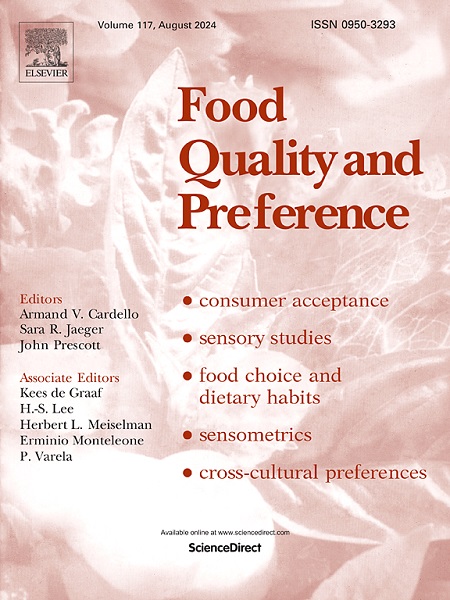Measuring the rejection of meat alternatives: Development and validation of a new scale
IF 4.9
1区 农林科学
Q1 FOOD SCIENCE & TECHNOLOGY
引用次数: 0
Abstract
Despite the potential benefits of meat alternatives for the environment and animal welfare, public skepticism remains. This study presents the development and validation of the Meat Alternatives Rejection (MAR) scale. After a pilot study (N = 510) refined the scale from fourteen to ten items, it was validated in a Swiss online survey (N = 1951) through four steps. First, exploratory factor analysis confirmed a one-factor structure with high factor loadings (0.63 to 0.80) and strong internal consistency (Cronbach’s alpha = 0.90). Second, convergent validity was supported by Pearson correlations with related variables, along with Average Variance Extracted (AVE = 0.525) and Composite Reliability (CR = 0.917). Third, discriminant validity was explored using a Heterotrait-Monotrait (HTMT) ratio of 0.634, indicating that the MAR scale measures a distinct construct. Lastly, MAR’s predictive validity was tested using two regression models: Model 1 (logistic regression) predicted the likelihood of being a meat alternative consumer versus nonconsumer, and Model 2 (two-step linear regression) predicted support for meat alternative marketing restrictions. In both models, the inclusion of MAR significantly improved the explained variance (Model 1: W=83.82, p < 0.001; Model 2: F(1, 1945) = 598.1, p < 0.001), with MAR outperforming other predictors (age, gender, education, meat attachment, and eco-knowledge). Overall, MAR is a robust and reliable tool for measuring consumers’ rejection of meat alternatives, demonstrating factorial, convergent, discriminant, and predictive validity. This new scale can help advance our understanding of the psychological mechanisms underlying the shift toward a more plant-based diet.
衡量对肉类替代品的排斥程度:新量表的开发与验证
尽管肉类替代品对环境和动物福利具有潜在的益处,但公众仍然持怀疑态度。本研究介绍了肉类替代品拒绝量表(MAR)的开发和验证。在试点研究(N = 510)将量表从 14 个项目改进为 10 个项目后,瑞士在线调查(N = 1951)通过四个步骤对其进行了验证。首先,探索性因子分析证实了该量表为单因子结构,具有较高的因子负荷(0.63-0.80)和较强的内部一致性(Cronbach's alpha = 0.90)。其次,与相关变量的皮尔逊相关性、平均方差提取率(AVE = 0.525)和综合信度(CR = 0.917)证实了聚合效度。第三,通过 0.634 的异质-单质(HTMT)比值探讨了判别效度,表明 MAR 量表测量的是一个独特的构念。最后,使用两个回归模型检验了 MAR 的预测有效性:模型 1(逻辑回归)预测成为肉类替代品消费者与非消费者的可能性,模型 2(两步线性回归)预测对肉类替代品营销限制的支持。在这两个模型中,纳入 MAR 都显著提高了解释方差(模型 1:W=83.82,p < 0.001;模型 2:F(1, 1945) = 598.1,p < 0.001),MAR 优于其他预测因素(年龄、性别、教育程度、肉类嗜好和生态知识)。总之,MAR 是测量消费者对肉类替代品排斥程度的一种可靠工具,具有因子效度、收敛效度、判别效度和预测效度。这一新量表有助于促进我们对向植物性饮食转变的心理机制的理解。
本文章由计算机程序翻译,如有差异,请以英文原文为准。
求助全文
约1分钟内获得全文
求助全文
来源期刊

Food Quality and Preference
工程技术-食品科技
CiteScore
10.40
自引率
15.10%
发文量
263
审稿时长
38 days
期刊介绍:
Food Quality and Preference is a journal devoted to sensory, consumer and behavioural research in food and non-food products. It publishes original research, critical reviews, and short communications in sensory and consumer science, and sensometrics. In addition, the journal publishes special invited issues on important timely topics and from relevant conferences. These are aimed at bridging the gap between research and application, bringing together authors and readers in consumer and market research, sensory science, sensometrics and sensory evaluation, nutrition and food choice, as well as food research, product development and sensory quality assurance. Submissions to Food Quality and Preference are limited to papers that include some form of human measurement; papers that are limited to physical/chemical measures or the routine application of sensory, consumer or econometric analysis will not be considered unless they specifically make a novel scientific contribution in line with the journal''s coverage as outlined below.
 求助内容:
求助内容: 应助结果提醒方式:
应助结果提醒方式:


